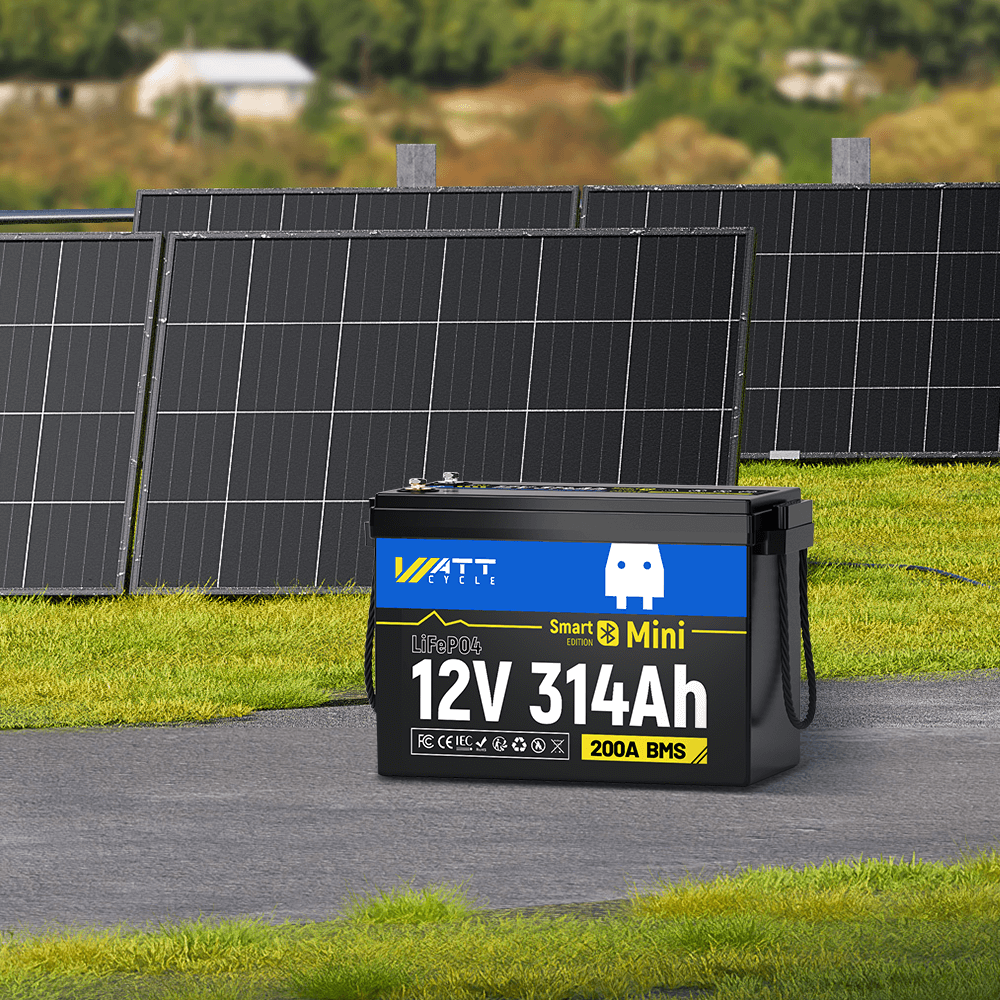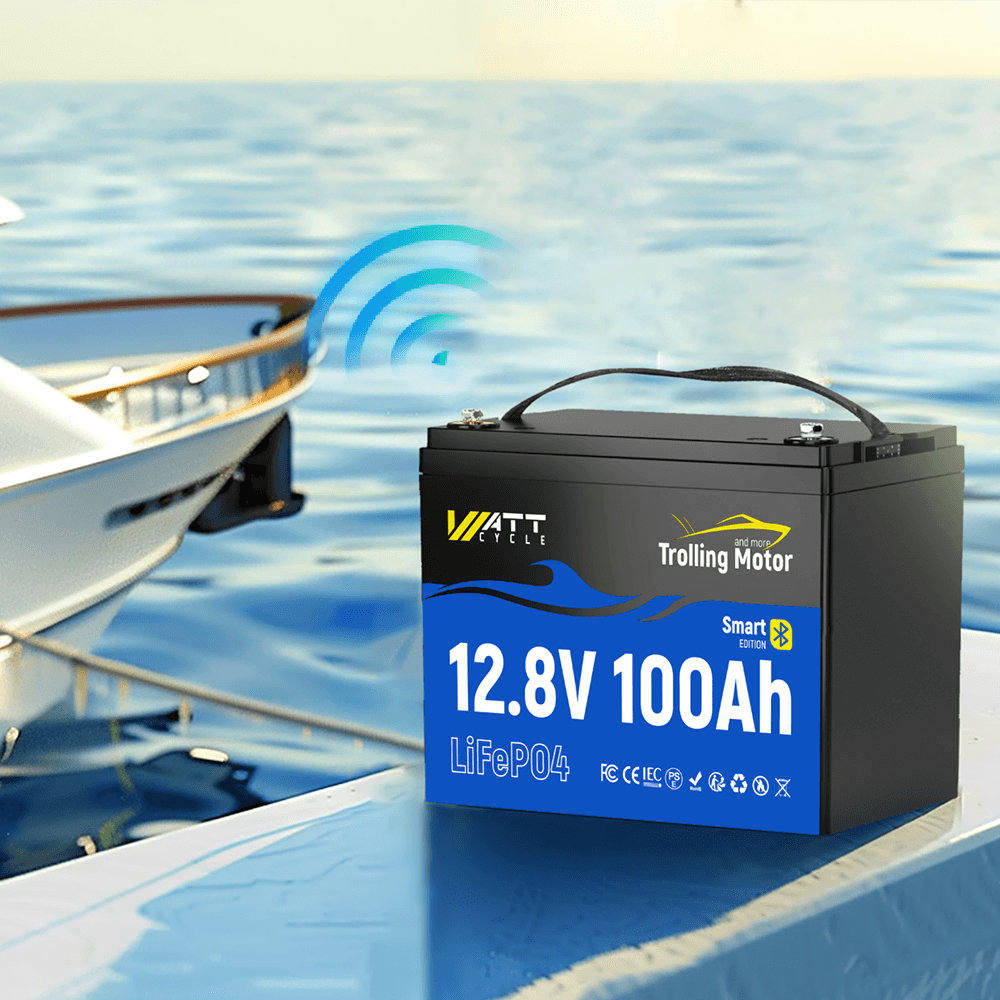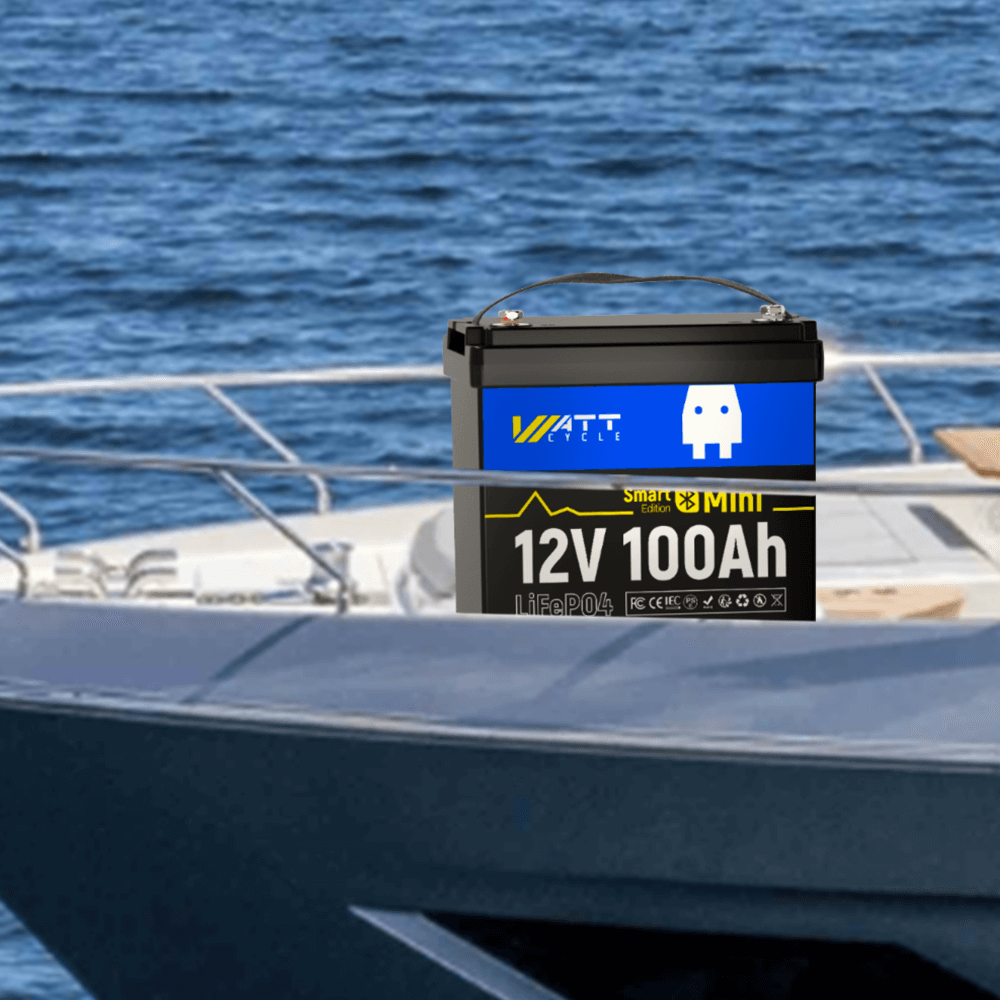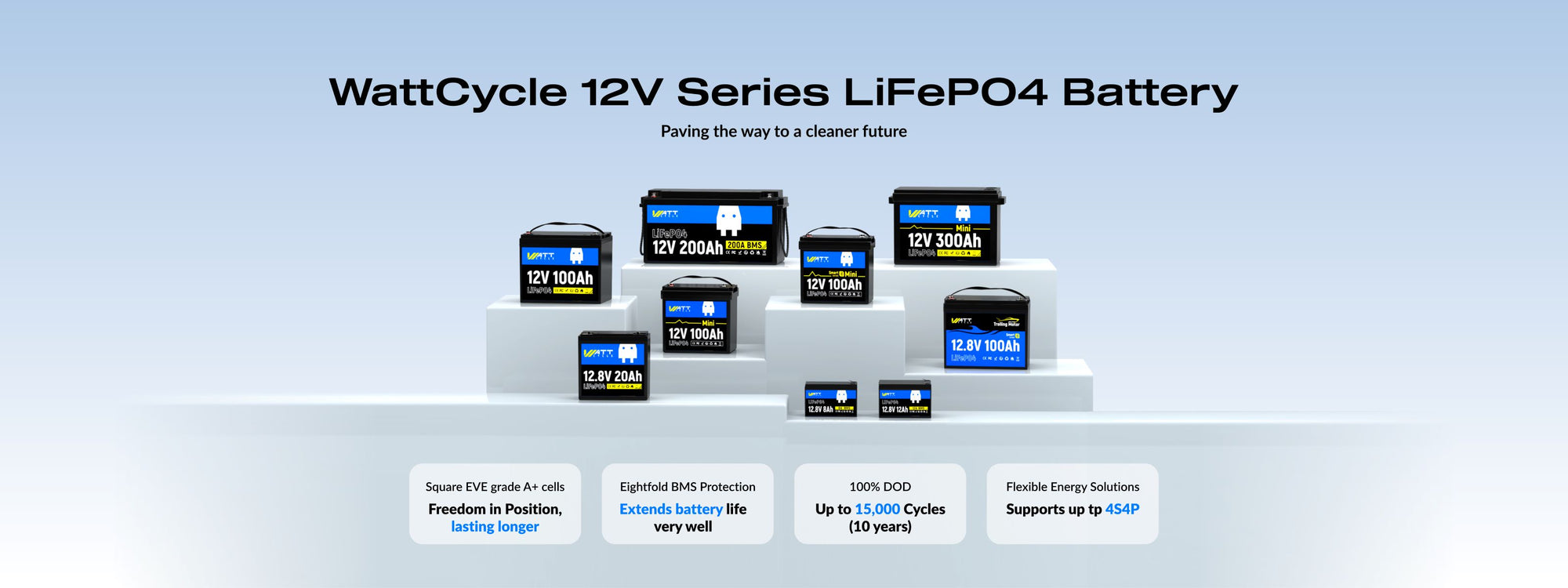Γιατί να επιλέξετε μπαταρίες WattCycle 12V LIFEPO4;
![run fast & further]()
Κύτταρα μπαταρίας υψηλής ποιότητας
Όλες οι μπαταρίες της WattCycle χρησιμοποιούν στοιχεία A+ κατηγορίας EV, παρέχοντας έως και 15.000 κύκλους στο 60% του DoD, εξασφαλίζοντας διάρκεια ζωής μπαταρίας 10 ετών, μειώνοντας τη συχνότητα αντικατάστασης της μπαταρίας και την ανησυχία για εξάντληση ενέργειας.
![enhanced protection]()
Περιεκτική προστασία
Όλες οι μπαταρίες της WattCycle είναι εξοπλισμένες με Σύστημα Διαχείρισης Μπαταρίας (BMS) για την προστασία της μπαταρίας από υπερφόρτιση, υπερεκφόρτιση, υπερένταση, βραχυκύκλωμα, υψηλή και χαμηλή θερμοκρασία.
![]()
Ultra Compact Design
Η WattCycle τηρεί την καινοτομία της ενεργειακής πυκνότητας της μπαταρίας. Το μέγεθος μιας μπαταρίας WattCycle 12V 280Ah Mini είναι ισοδύναμο με αυτό μιας μπαταρίας μολύβδου-οξέος 12V 100Ah, αλλά η χωρητικότητά της είναι τριπλάσια από αυτή μιας μπαταρίας μολύβδου-οξέος.
![WattCycle_LiFePO4_Battery_Lightweight_and_Compact]()
Κλιμακωτή ενεργειακή λύση
Η μπαταρία WattCycle 12V υποστηρίζει μέγιστη επέκταση μπαταρίας 4P4S. Αυτό σημαίνει 4 μπαταρίες παράλληλα και 4 μπαταρίες σε σειρά, οι οποίες θα σχηματίσουν ένα σύστημα μπαταριών LiFePO4 48V. Επεκτείνετε αυθαίρετα για να καλύψετε τις διαφορετικές ενεργειακές σας ανάγκες.
Μπαταρίες 12V
WattCycle 12V LiFePO4 Batteries Teardown - Trustworthy Battery Cells And Frames
Let's look at what the battery expert says about WattCycle 12V LiFePO4 Batteries! WattCycle batteries are made of high-performance EV cells, and there is a solid framework to tighten the cells, which ensures your battery survives the turbulence.
WattCycle 12V BATTERIES LIFEPO4 Πλεονεκτήματα
Είναι πάντα η πρώτη σας επιλογή σε μπαταρίες LifePo4 12V.
- Οι καλύτερες αντικαταστάσεις για μπαταρίες μολύβδου-οξέος
- Οι μπαταρίες λιθίου-φωσφορικού σιδήρου είναι σταθερές και δεν είναι επιρρεπείς σε έκρηξη.
- Ευφυές: Το ενσωματωμένο σύστημα διαχείρισης μπαταριών (BMS) παρέχει πολλαπλές προστασίες
- Παθητική λειτουργία εξισορρόπησης μπαταρίας
- Δωρεάν συντήρηση
- Χαμηλό ποσοστό αυτοεκφόρτισης
- Υποστήριξη εκκένωσης 1C
- Γρήγορη και ασφαλής φόρτιση
- Προστασία διακοπής χαμηλής θερμοκρασίας
- Μακριά διάρκεια ζωής & 10 χρόνια σταθερής υπηρεσίας
- Χωρίς ρύπανση και πράσινη ενέργεια

Review Wattcycle - Πραγματική ανατροφοδότηση από πελάτες
Συχνές ερωτήσεις
Μπορούν οι μπαταρίες WattCycle 12V LifePo4 σε ακραίες θερμοκρασίες;
Οι συνιστώμενες θερμοκρασίες λειτουργίας για τις μπαταρίες WattCycle 12V LiFePO4 είναι:
- Φόρτιση: 0°C – 65°C
- Εκφόρτωση: -20°C – 70°C
- Αποθήκευση: 0°C – 60°C
Το ενσωματωμένο Σύστημα Διαχείρισης Μπαταρίας (BMS) παρέχει προστασία από υψηλές και χαμηλές θερμοκρασίες, εξασφαλίζοντας ασφαλή λειτουργία. Για παράδειγμα:
- Προστασία χαμηλής θερμοκρασίας: Διακόπτει αυτόματα τη φόρτιση εάν η θερμοκρασία πέσει κάτω από τους -20°C για την αποφυγή ζημιάς.
- Προστασία από υψηλή θερμοκρασία: Διακόπτει τη φόρτιση/εκφόρτιση εάν οι θερμοκρασίες υπερβούν τους 65°C (φόρτιση) ή τους 70°C (εκφόρτιση).
Βασικές Σημειώσεις:
- Απόδοση σε ακραίες συνθήκες: Ενώ η μπαταρία μπορεί να λειτουργήσει σε αυτά τα εύρη, η βέλτιστη απόδοση επιτυγχάνεται σε θερμοκρασία 20°C – 25°C.
- Αποφύγετε την παρατεταμένη έκθεση: Η παρατεταμένη χρήση εκτός των συνιστώμενων ορίων μπορεί να μειώσει τη διάρκεια ζωής ή την απόδοση.
- Αποθήκευση: Φυλάξτε την μπαταρία σε ξηρό περιβάλλον με ελεγχόμενη θερμοκρασία όταν δεν τη χρησιμοποιείτε.
Η ασφάλεια πάνω απ' όλα!
Το BMS διασφαλίζει την ασφαλή χρήση, αλλά παρακολουθεί πάντα την κατάσταση της μπαταρίας σε ακραίες συνθήκες.
Μπορώ να συνδέσω μπαταρία LifePO4 12V 100AH με μπαταρία 12V 100Ah;
Δεν συνιστάται. Το WattCycle απαιτεί τέσσερις κανόνες για την ασφαλή σύνδεση μπαταριών σε σειρά ή παράλληλα:
- Ίδια μάρκα
- Ίδια τάση
- Ίδιο ρεύμα (χωρητικότητα)
- Αγοράστηκε εντός 6 μηνών
Γιατί η ανάμειξη διαφορετικών μπαταριών είναι επικίνδυνη:
- Ανισορροπημένη απόδοση: Η μπαταρία 12V 100Ah LiFePO4 και η μίνι μπαταρία πιθανότατα διαφέρουν ως προς την χωρητικότητα, την εσωτερική αντίσταση ή την ηλικία, με αποτέλεσμα την ανομοιόμορφη φόρτιση/εκφόρτιση.
- Μειωμένη απόδοση: Η μία μπαταρία μπορεί να εξαντληθεί πιο γρήγορα, αναγκάζοντας την άλλη να υπερλειτουργήσει.
- Κίνδυνοι ασφαλείας: Οι ασύμβατες μπαταρίες μπορεί να υπερθερμανθούν, να υποβαθμιστούν πρόωρα ή ακόμα και να παρουσιάσουν βλάβη.
Σύσταση:
- Χρησιμοποιήστε πανομοιότυπες μπαταρίες (ίδιας μάρκας, τάσης, χωρητικότητας και ηλικίας) για ασφαλή και σταθερή λειτουργία.
- Εάν χρειάζεστε μεγαλύτερη χωρητικότητα ή τάση, προτιμήστε έναν τύπο μπαταρίας (e.g., Εάν χρειάζεστε ένα σύστημα μπαταρίας 24V 100Ah, τότε συνιστάται να αγοράσετε ένα Μπαταρία 24V 100Ah αντί για 2 μπαταρίες LiFePO4 12V 100Ah).
Ποια είναι η διαφορά μεταξύ μιας μπαταρίας LifePo4 12V 100Ah και μιας μπαταρίας μίνι 12V 100Ah;
Η κύρια διαφορά έγκειται στο φυσικό τους μέγεθος:
Διαστάσεις μπαταρίας 12V 100Ah: Μ260 x W168 x Υ209 χιλιοστά
Μίνι μπαταρίαδιαστάσεις: Μ229 x W138 x Υ208 χιλιοστά
Πώς μπορώ να κατεβάσω την εφαρμογή WattCycle;
Μπορείτε να αναζητήσετε το WattCycle στο Google Play ή Κατάστημα Apple, και θα βρείτε την εφαρμογή με το όνομα WattCycle.
Ποια δεδομένα μπορώ να δω μέσω της εφαρμογής WattCycle;
Αφού συνδέσετε την μπαταρία, μπορείτε να δείτε την κατάσταση φόρτισης (SOC), τη θερμοκρασία, την τάση και το ρεύμα, να ελέγξετε τη φόρτιση και την εκφόρτιση της μπαταρίας, καθώς και προειδοποιήσεις στη διεπαφή του κέντρου δεδομένων. Στις προηγμένες ρυθμίσεις, μπορείτε να ορίσετε το μέγιστο ρεύμα φόρτισης και εκφόρτισης και τη θερμοκρασία.
Ποια είναι η διαφορά μεταξύ της μπαταρίας LifePo4 12V 100Ah, της μπαταρίας Bluetooth 12V 100Ah και της μπαταρίας 12V 100Ah;
Σύγκριση μεγεθών:
- Διαστάσεις τυπικής μπαταρίας 12V 100Ah: Μ260 × W168 × Υ209 χιλ.
- Μίνι μπαταρία 12V 100Ah & Μίνι μπαταρία Bluetooth 12V 100Ah Διαστάσεις: Μ229 × W138 × Υ208 χιλ.
Λειτουργικές διαφορές:
- Μπαταρία LiFePO4 12V 100Ah & Μίνι μπαταρία 12V 100Ah:
Προστασία από χαμηλή θερμοκρασία: Διακόπτει αυτόματα την αποφόρτιση όταν οι θερμοκρασίες πέσουν κάτω από τους -20°C για την αποφυγή ζημιών.
Δεν υπάρχει συνδεσιμότητα Bluetooth. - Μίνι μπαταρία Bluetooth 12V 100Ah:
Προστασία από χαμηλή θερμοκρασία: Όπως παραπάνω.
Παρακολούθηση Bluetooth: Επιτρέπει την παρακολούθηση της κατάστασης της μπαταρίας σε πραγματικό χρόνο (e.g., τάση, επίπεδο φόρτισης, θερμοκρασία) μέσω εφαρμογής για smartphone.
Πώς πρέπει να εκφορτώσω τις μπαταρίες WattCycle 12V LifePo4 σε θερμοκρασίες υπο-μηδενικού;
Μην ανησυχείτε! Όλες οι μπαταρίες WattCycle LiFePO4 διαθέτουν ενσωματωμένη προστασία χαμηλής θερμοκρασίας, επιτρέποντας την ασφαλή εκφόρτιση ακόμη και σε θερμοκρασίες τόσο χαμηλές όσο -20°CΑυτό σημαίνει ότι οι συσκευές που λειτουργούν σε θερμοκρασίες κατάψυξης μπορούν να συνεχίσουν να τροφοδοτούνται αξιόπιστα με ρεύμα.
Πόσες ώρες διαρκέσει μια μπαταρία LIFEPO4 12V 200AH;
Ο χρόνος λειτουργίας της μπαταρίας επηρεάζεται από πολλούς παράγοντες, όπως η χωρητικότητά της, το συνδεδεμένο φορτίο και η κατάσταση. Για παράδειγμα, μια καινούργια μπαταρία έχει καλύτερη απόδοση από μια μεταχειρισμένη, καθώς η χωρητικότητά της μειώνεται ελαφρώς με επαναλαμβανόμενους κύκλους φόρτισης. Ωστόσο, μπορείτε να υπολογίσετε τον χρόνο λειτουργίας χρησιμοποιώντας έναν απλό τύπο που βασίζεται στην κατανάλωση ενέργειας και τη χωρητικότητα της μπαταρίας:
Χρόνος λειτουργίας (ώρες) = Χωρητικότητα μπαταρίας (Wh)/Συνολική κατανάλωση ενέργειας συσκευής (W)
Παράδειγμα:
Αν έχετε μια μπαταρία LiFePO4 12V 200Ah και συνδέσετε μια λάμπα 50W και ένα ηχείο 50W, ο χρόνος λειτουργίας θα είναι:
2560Wh/(50W + 50W) = 25,6 ώρες
Είναι καλύτερο να έχετε δύο μπαταρίες LifePO4 12V 100AH ή μία μπαταρία LifePo4 12V 200AH;
Δυο Μπαταρίες 12V 100Ah LiFePO4 σε παράλληλη σύνδεση και μία μόνο μπαταρία 12V 200Ah LiFePO4 παρέχουν την ίδια συνολική χωρητικότητα (200Ah). Ωστόσο, η χρήση μίας μόνο μπαταρίας 200Ah προσφέρει βασικά πλεονεκτήματα:
- Συνέπεια & Σταθερότητα
Μία μόνο μπαταρία εξασφαλίζει ομοιόμορφη γήρανση των στοιχείων, ισορροπία τάσης και σταθερή απόδοση.
Οι παράλληλες διαμορφώσεις ενέχουν κίνδυνο ανισορροπιών λόγω διαφορών στην εσωτερική αντίσταση ή μικρών διακυμάνσεων χωρητικότητας μεταξύ των μπαταριών. - Απλούστερη εγκατάσταση
Λιγότερες συνδέσεις καλωδίωσης μειώνουν την πολυπλοκότητα και τα πιθανά σημεία βλάβης.
Εξοικονομεί χώρο και ελαχιστοποιεί την προσπάθεια εγκατάστασης. - Συμπαγής σχεδιασμός
Μία μόνο μπαταρία LiFePO4 12V 200Ah καταλαμβάνει λιγότερο φυσικό χώρο από δύο μπαταρίες LiFePO4 12V 100Ah.
Πότε να επιλέξετε δύο μπαταρίες LiFePO4 12V 100Ah:
Πλεονασμός: Αν η μία μπαταρία χαλάσει, η άλλη μπορεί ακόμα να παρέχει μερική τροφοδοσία.
Επεκτασιμότητα: Ευκολότερη σταδιακή επέκταση της χωρητικότητας (e.g., προσθέτοντας περισσότερες μπαταρίες αργότερα).
Τελική Σύσταση:
Για τις περισσότερες εφαρμογές (e.g., ηλιακή αποθήκευση, τροχόσπιτα, εφεδρική ισχύς), προτιμάται μία μόνο μπαταρία LiFePO4 12V 200Ah για απλότητα, αξιοπιστία και εξοικονόμηση χώρου. Χρησιμοποιήστε παράλληλες διατάξεις μόνο εάν ο πλεονασμός ή η επεκτασιμότητα αποτελούν κρίσιμη προτεραιότητα.
Πόσο καιρό θα διαρκέσει μια μίνι μπαταρία 12V 280AH;
Ο χρόνος λειτουργίας της μπαταρίας επηρεάζεται από πολλούς παράγοντες, όπως η χωρητικότητα της μπαταρίας, το συνδεδεμένο φορτίο και η κατάσταση της μπαταρίας. Για παράδειγμα, μια καινούργια μπαταρία έχει καλύτερη απόδοση από μια μεταχειρισμένη, καθώς η χωρητικότητά της μειώνεται ελαφρώς με επαναλαμβανόμενους κύκλους φόρτισης. Ωστόσο, μπορείτε να υπολογίσετε τον χρόνο λειτουργίας χρησιμοποιώντας έναν απλό τύπο που βασίζεται στην κατανάλωση ενέργειας και τη χωρητικότητα της μπαταρίας:
Χρόνος λειτουργίας (ώρες) = Χωρητικότητα μπαταρίας (Wh)/Συνολική κατανάλωση ενέργειας συσκευής (W)
Παράδειγμα:
Αν έχετε μια μπαταρία Mini 12V 280Ah και συνδέσετε μια λάμπα 50W και ένα ηχείο 50W, ο χρόνος λειτουργίας θα είναι:
3584Wh/(50W + 50W) = 35,84 ώρες
Αυτός ο απλός τύπος βοηθά στην εκτίμηση του χρόνου εκτέλεσης υπό διαφορετικά φορτία. Να λαμβάνετε πάντα υπόψη πραγματικούς παράγοντες όπως η θερμοκρασία και η γήρανση της μπαταρίας για πιο ακριβείς προβλέψεις.



























